Self-propelled aircraft from aircraft manufacturers. Project ACS-57 OKB-115
Glider and self-propelled gun
In the creation of new armored vehicles for the Airborne Forces the leading role was played by enterprises that had the necessary experience in this field. However, in 1948, the SAU decided to try OKB-115, headed by A.S. Yakovlev. At that time, the bureau was engaged in the development of the Yak-14 airborne glider, and at the same time it was planned to create a lightweight ACS that was compatible with it. The new model was named ASU-57 (“Airborne self-propelled unit, 57 mm”), because of which it can be confused with the development of the same name of plant No. XXUMX.
According to some sources, the self-propelled gun project ASU-57 was not created by OKB-115, but by the Kharkov Tank Repair Plant No. 115. However, data discovered and published in recent years refute this version. A new model of land equipment did exactly aviation OKB.
Despite the lack of experience, OKB-115 quickly coped with the new task. The design assignment for the ACS appeared at the beginning of February 1948, and by the end of February a set of drawings had to go to production. Start of production tests scheduled for the end of March. During the development, it was necessary to adjust the approved appearance of the car, but no radical changes were foreseen.
Design features
The project ACS-57 envisaged the construction of a tracked self-propelled artillery system for a log cabin layout with a partially open fighting compartment. The front of the hull was given under the arms and crew seats, and behind them was the engine compartment. Measures were taken to simplify operation in the Airborne Forces, in particular, landing.
The ACS received a welded body with differentiated armor thickness from 4 to 12 mm. The frontal projection was covered by a large inclined sheet, above which was placed the so-called. lamp - curved shield with viewing devices. For suspension under the cargo glider, the lantern was folded backwards and downwards. The front sheet had a niche for a gun mount.
In the rear of the hull, the GAZ-M-20 gasoline engine with an 50 horsepower capacity was mounted on the right along the side. The transmission included a bevel main gear, a four-speed GAZ-AA gearbox, two side clutches and two single-row side gearboxes. The engine and transmission were controlled by a traditional set of levers and pedals. The electrical system of the machine was based on the generator GBF-4105.
The chassis had four rubber-supported road wheels with a torsion bar on each side. The same skating rink without a bandage was used as a steering wheel. Driving wheels were placed at the back. Caterpillar collected from tracks, borrowed from the tractor T-20 "Komsomolets".
In the forward part of the body placed the machine for mounting the main armament. ASU-57 received an automatic gun 113P caliber 57 mm, originally created for promising fighter aircraft. The gun was mounted with a shift back, because of which only a limited part of the barrel with a muzzle brake protruded through the embrasure. The barrel passed through the habitable compartment, and the breech was located next to the engine compartment.
The gun 113P used automation based on a short recoil of the barrel. Technical rate of fire - 133 shot per minute. Next to her breech on the left was a feeding mechanism with a box for loose tape on 15 unitary shots 57х350 mm. Nearby were two boxes of 16 and 20 shells. Normal ammunition was determined in 31 shot, when overloaded - 51 with the placement of additional tape in a separate box. Recharging after spending the first tape was carried out hydraulically. The next recharge required the intervention of the crew.
The gun mount received hydraulic drives for aiming in two planes, as well as a hydraulic reloading mechanism. Horizontal guidance was carried out in a sector with a width of 16 °, vertical - from -1 ° to + 8 °. Aviation collimator sight PBP-1A was used for guidance. Later it was replaced by the K8-T product borrowed from tank machine gun installations.
The crew consisted of only two people. To the right of the gun in the nose of the case was a driver. Left placed commander-gunner. For observation, they had their own viewing instruments in the lamp. Access to crew seats was through the roof. Normally, the ACS should have had a radio station, but it was not installed on an experienced car.
The length of the ACS-57 from OKB-115, taking into account the gun, slightly exceeded 4,5 m. The width is 3,8 m, the height is only 1,38 m in a combat position or slightly more than 1 m with a folded lantern. Combat weight - 3255 kg. The car had to reach speeds of up to 45 km / h, and the 120-l tank gave 167 km of power reserve. ASU-57 had to overcome various obstacles, incl. fords.
Failed tests
In the early summer of 1948, Plant No. 115 handed over a prototype of the new amphibious assault landing system to the Kubinka training ground for testing by the army. Within a few weeks, the car showed running and fire qualities. The test results were far from desired.
The power plant SAU was weak. Service was difficult. There was no shielding wiring. After 62 h work the engine had to be changed due to a serious breakdown. The transmission, however, worked out properly and without significant problems. The chassis was not strong enough, and therefore regularly required to tighten the bolts and nuts. There were no slats above the caterpillar, because of which the self-propelled gun was covered with dust. The lack of a silencer on the exhaust pipe created discomfort and led to the risk of fire.
Fire tests were limited to 21 shot, after which all the flaws became clear. The muzzle brake of the 113P gun raised dust, interfering with observation, and also had a negative effect on the crew. In addition, at the first shot, he broke a single headlamp. Hydraulic guidance system provided insufficient angles of movement of the gun. At the same time there was no synchronous movement of the gun and sight. During operation, the pressure in the hydraulic system quickly fell, interfering with the guidance. The design of the guidance systems eliminated the use of a traveling stopper gun.
The collimator aircraft sight made it difficult to guide at long distances. The ammunition system was unsuccessful. The project provided for a quick replacement of the tape by the gunner, but in practice, reloading required the work of two gunners and took about 10-15 minutes. At the same time, people had to leave the protected compartment.
There were also many other flaws. Poor protection of the crew against shelling from the side and from the stern, lack of entrenching tools, insufficient set of spare parts, etc. were noted.
According to the test results, the ACS-57 was recognized as unsuccessful and not meeting the requirements of the army. Experienced car returned to the factory. Soon, the comparative tests of several new models were completed, and the machine of the same name from plant No. XXUMX was put into service.
Attempt to upgrade
In the same year, 1948, OKB-115 attempted to correct the deficiencies and improve the existing ACS. New proposals implemented on the layout, and then in the form of a full-fledged prototype.
The modernization project included the abandonment of a half-open habitable compartment. Behind the lantern appeared additional armor, forming the roof of the wheelhouse. Redesigned viewing devices in the lamp. Boxes for spare parts and other property, as well as external fixings, have been seriously upgraded. The composition of the power plant remained, but all auxiliary units were altered, which caused criticism during testing.
The gun mount lost its hydraulics and was driven by hand mechanisms. The angle of inclination was brought to -2 ° with the possibility of increasing to -5 ° by opening the hatches above the breech. The hydraulics in the reloading mechanism of the gun were replaced by pneumatics. The sight PBP-1А was replaced with an OP-1 with magnification. Introduced other minor improvements.
ASU-57 still did not have machine-gun armament, but now it was proposed to supplement the gun with rockets. At the stern, it was planned to mount a lightweight, removable launcher on 30 rockets PC-82. The launch control was carried out from under the armor or from the remote control.
The updated ASU-57 retained its previous dimensions, but it became heavier to 3,33 tons. The launcher for the PC-82 added 320 kg of mass. Mobility remained at the same level.
At the end of October, the second version of 1948 ACS-57 was sent to Kubinka for new tests. After the checks, in early February 1949 was returned to plant number XXUMX without any complaints about the operation and reliability of the units. However, the military did not consider the OKB-115 project in the context of future rearmament.
The further fate of the experienced ACS-57 is not known for certain. Apparently, it did not save and disassembled for parts. The first and last project of an aviation OKB-115 in the field of land armored vehicles did not give the desired results. It should be noted that the bureau did make a significant contribution to the development of the airborne troops. His glider Yak-14 entered service and has been actively used for many years. However, he had to carry self-propelled automatic control systems of the bureau.
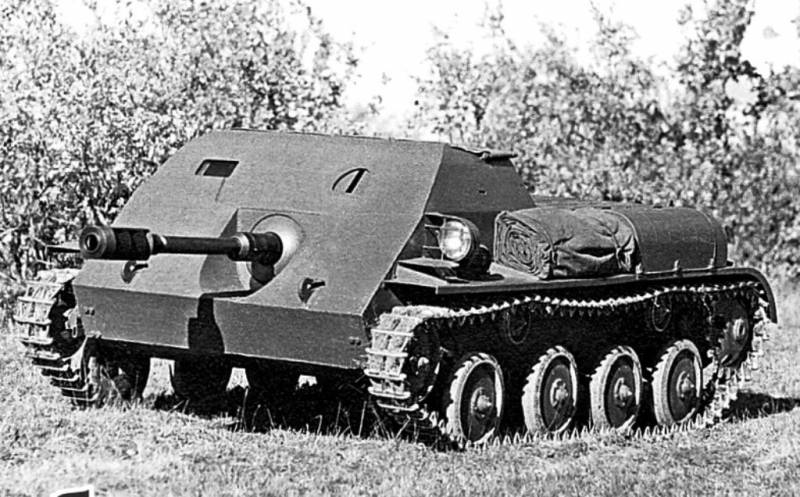
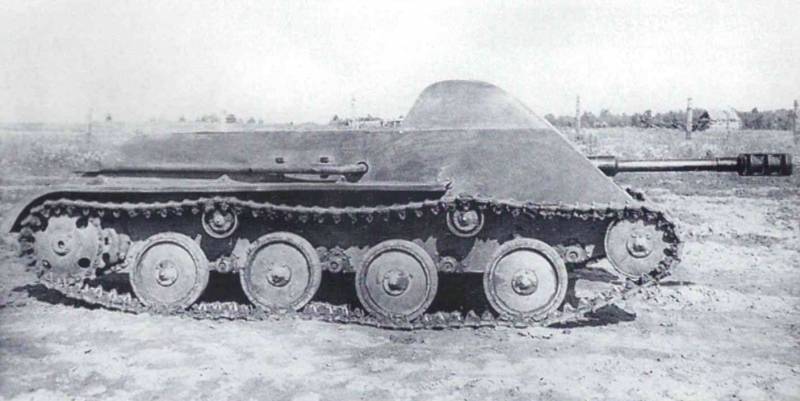
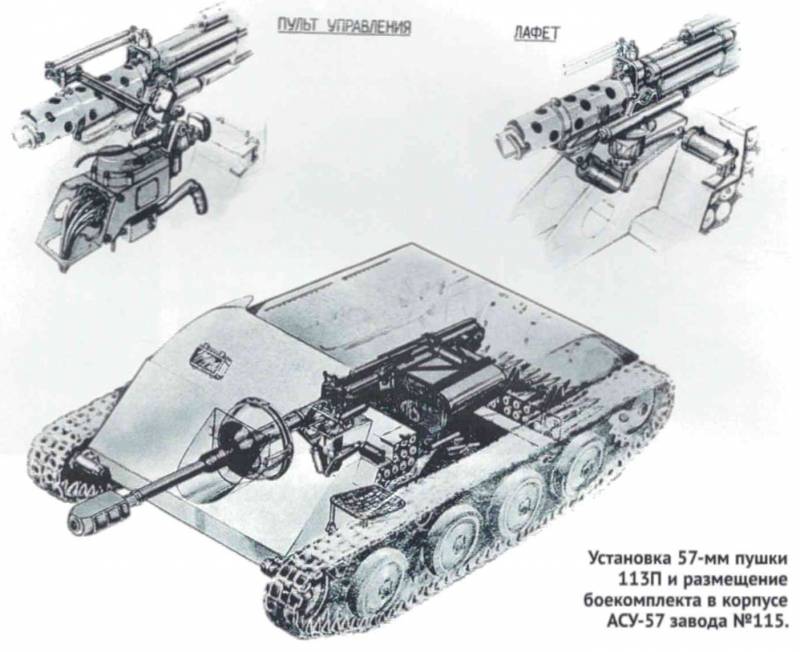
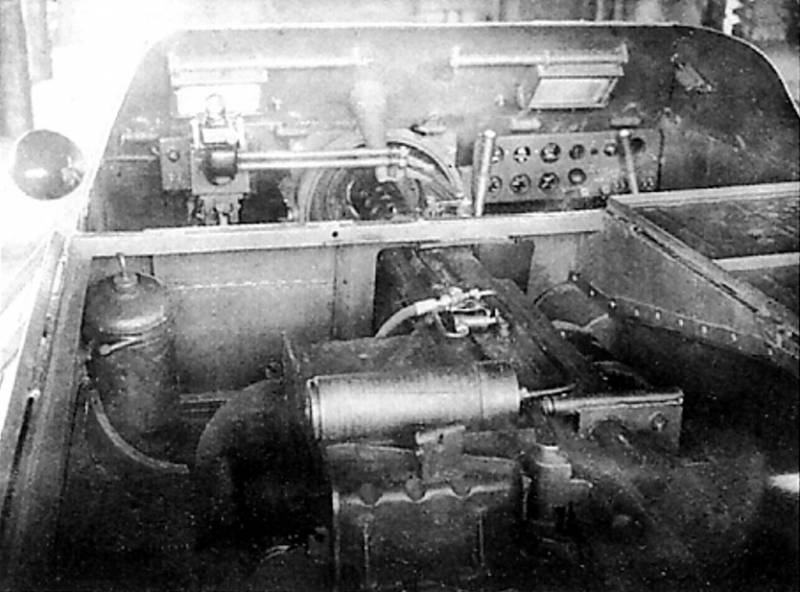
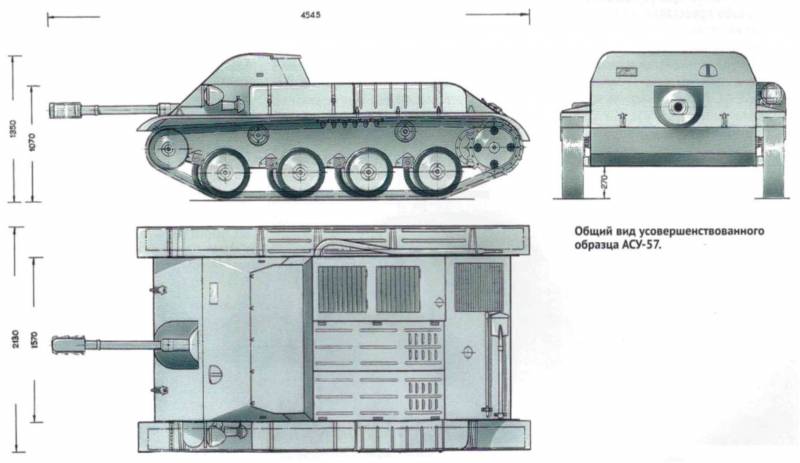
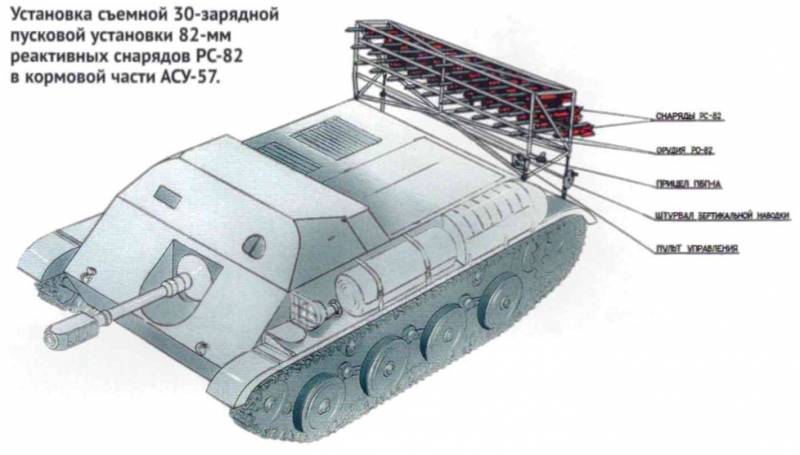
Information